Our goal is to keep as much bone as possible, particularly over 50, and exercises create the muscle strength and the bone health that keeps us upright, reduce falls and keeps our bones strong.
Over time, bone loss happens, and new bone growth slows. Bones get weaker, and after 30, we break down more bone than we rebuild.
Bones are living, growing tissues that are formed and re-absorbed, helping the body maintain a constant controlled amount of bone. Bones are also the mechanical support for muscles and connective tissue, and bones are the levers for muscle movement.
When too much bone mass is lost, changes occur in the structure of the bone tissue, and osteoporosis develops. Exercise is a key ingredient in an osteoporosis plan. Exercise that creates muscle strength that helps with coordination and balance. This in turn, helps prevent falls and fractures.
Risk of Osteoporosis Increases with Gender and Age
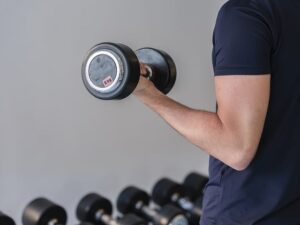 There are two major factors that increase your risk of developing osteoporosis, gender and age.
There are two major factors that increase your risk of developing osteoporosis, gender and age.
Both men and women can develop osteoporosis, but women are 4 times more likely to develop osteoporosis than men. Osteoporosis is the major cause of fractures in postmenopausal women and in older men.
“At age 50, one in two women and one in four men will have an osteoporosis-related fracture in their lifetimes. Another 30% have low bone density that puts them at risk of developing osteoporosis. This condition is called osteopenia.”
Osteoporosis is called a silent disease because there are typically no symptoms until you have a broken bone or compression factures in your vertebrae. When symptoms do show up, they usually show up as severe back pain, loss of height, spinal malformations.
Hormones can play a role, as they do with most goings-on in the body. When estrogen lowers in women after menopause, it can increase the risk factor for osteoporosis. If a woman has hormonal disorders or has an extreme level of physical activity and menstrual periods have stopped, it can also lead to a risk factor of developing osteoporosis.
In men, conditions that cause low levels of the hormone testosterone (obesity, diabetes, thyroid function, etc.) can put them at risk for osteoporosis. The gradual decrease that comes with maturing, however, doesn’t seem to play a major role in developing osteoporosis.
Your Bone Structure, Body Weight and Your Genetics
 Other factors that can contribute to osteoporosis is your bone structure and your body weight.
Other factors that can contribute to osteoporosis is your bone structure and your body weight.
Slender, thin-boned women and men are at greater risk because they have less bone to lose compared to larger boned women and men.
Bone loss accelerates during the menopausal transition. This transition period could be from late perimenopause including the first few years after menopause. Losing weight during this time is seen as a risk factor for osteoporosis. You’re likely to lose bone along with weight loss.
This is the time when you want to boost your calcium and Vitamin D as well as your fitness over 50 strength workouts.
Genetics influence the bone mineral density and fracture risk. Learning more about the genetic makeup influencing this disease, researchers are looking to steer toward more correct and targeted treatments.
Food and Its Influence on Bone Health
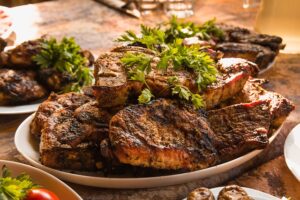 While osteoporosis is not curable, food has a big influence and done well, it can improve bone health. Good nutrition can help manage a risk factor and good nutrition plays a significant role in treatment. Because without enough minerals, particularly calcium and Vitamin D, bones can become weak.
While osteoporosis is not curable, food has a big influence and done well, it can improve bone health. Good nutrition can help manage a risk factor and good nutrition plays a significant role in treatment. Because without enough minerals, particularly calcium and Vitamin D, bones can become weak.
Also, protein is a key nutrient for the bone health. There has been a lot of controversy over protein and its role with bone health, but it seems to have settled out in favor of adding protein.
Since bone has a continual turnover and remodeling process, bone needs a good amount of amino acids and minerals that are found in protein. Protein helps support the formation and maintenance of bone.
Still, a cautionary flag goes up with too much protein causing the body to lose calcium. Most older adults, however, are low on protein. If you have concern, you can make up a difference by adding dairy products like yogurt, cheese, calcium-fortified cottage cheese, which are high in protein and contain calcium.
Other foods that influence bone health are your green leafy vegetables, broccoli, kale, collard greens, turnip greens and mustard greens. These guys always show up with lots of nutrients to boost your health.
Fresh and dried figs come to the table, as do canned fish and salmon with the bones, please; almonds and Brazil nut, which I just happen to love.
Prunes reduce inflammation and oxidative stress, both cause inflammation and contribute to bone loss. You want about 50 grams of prunes a day, that’s about 5 or 6 prunes, but start out slow with 1 to 2 and work your way up.
Blackberries, blueberries and mulberries should also show up in your diet along with grapes, kiwi and pomegranate. All of these delicious fruits are full of nutrients, antioxidants and help with reducing the inflammation and oxidative stress that contribute to bone loss.
Exercises for bone health for over 50
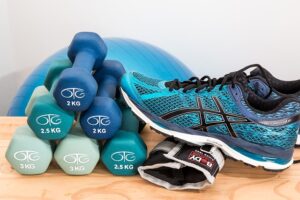 Weight bearing and resistance exercises are the best exercises for bone health for over 50. Weight bearing exercises that often include aerobic work (good for the heart) force you to work against gravity and require you to be on your feet with your bones supporting your weight. Walking, hiking, jogging, climbing stairs, tennis, dancing, even elliptical machines, all are weight bearing and aerobic exercises.
Weight bearing and resistance exercises are the best exercises for bone health for over 50. Weight bearing exercises that often include aerobic work (good for the heart) force you to work against gravity and require you to be on your feet with your bones supporting your weight. Walking, hiking, jogging, climbing stairs, tennis, dancing, even elliptical machines, all are weight bearing and aerobic exercises.
Resistance training develops your muscle strength. Resistance training includes free weights, resistance bands and bodyweight exercises. Check out the ones we included below.
Resistance training is particularly important for the muscles in the back and along the spine to keep your posture upright. Resistance training helps maintain bone density, too.
Don’t get fooled into thinking that because you have osteopenia (low bone density) or osteoporosis (loosing more bone than can be generated) that you should stay away from exercise.
The lack of exercise with this disease can be debilitating and impair your mobility and independence.
In fact, it’s low levels of physical activity and/or prolonged periods of inactivity that contribute to an increase in bone loss.
Work with a knowledgeable professional who can design the correct program to keep you strong and safe.
Weight bearing, resistance and balance exercises are all important for bone health over 50. And at Fitness Rehab RX, we have great video workouts for over 50, that you can easily access to address each type of these exercises. Our workouts vary in length and in level of difficulty. You can check them out here.
But for those really short on time, we also put together a mini compilation of exercises that create muscle strength and bone health for Over 50 that you can do right now.
Just Scroll down, get up and join us!
Squat Shoulder Press Dumbbell
- Hold dumbbells up by your shoulders. Keep your wrists straight and don’t rest the dumbbells on your shoulders.
- Hinge hips back and Squat down. Your knees should follow the direction of your toes.
- Push from your heels and your glutes to stand from your squat.
- As you are coming up from your squat
Back Lunge Bicep Curl Dumbbell
- Take a big step back.
- Bend both knees to 90 degrees. Keep your torso tall with shoulder in line with the back knee.
- With elbows by your sides and palms forward, bend your elbows for a bicep curl.
- Bring feet together and arms down by your sides.
Jump Squat Pick Up Dumbbell
- Place a dumbbell vertically on the floor between your feet.
- Jump feet apart (about shoulder distance), squat down and pick up the dumbbell.
- Holding the dumbbell in one hand, jump feet together.
- Change hands with the dumbbell.
- Jump feet apart, squatting down and put the dumbbell back on the floor centered between your feet.
- Repeat.
Kneeling Straight Arm Press Back Dumbbell
- Kneeling on the floor, lean slightly forward, bending from the hips, not the waistline. Keep abdominals engaged.
- With straight arms and palms facing the back, make small presses, keeping the triceps engaged.
Skaters Hop Over
- Place a dumbbell vertically on the floor.
- Hop over the dumbbell to one side, bringing the other leg to cross behind and a slight squat or bending of the front leg. Keep the back leg off the floor.
- Hop over the dumbbell to the other side, and repeat bringing the opposite leg to cross behind adding a slight squat to the movement.
Our 8 Proven Strategies for Better Health After 50 and our 5 Steps to Boost Your Health and Your Productivity include strategies and tips on the top concerns of men and women cresting middle age and beyond. It also includes practical easy-to-do solutions that fit into those busy schedules so you can improve your health and fitness.
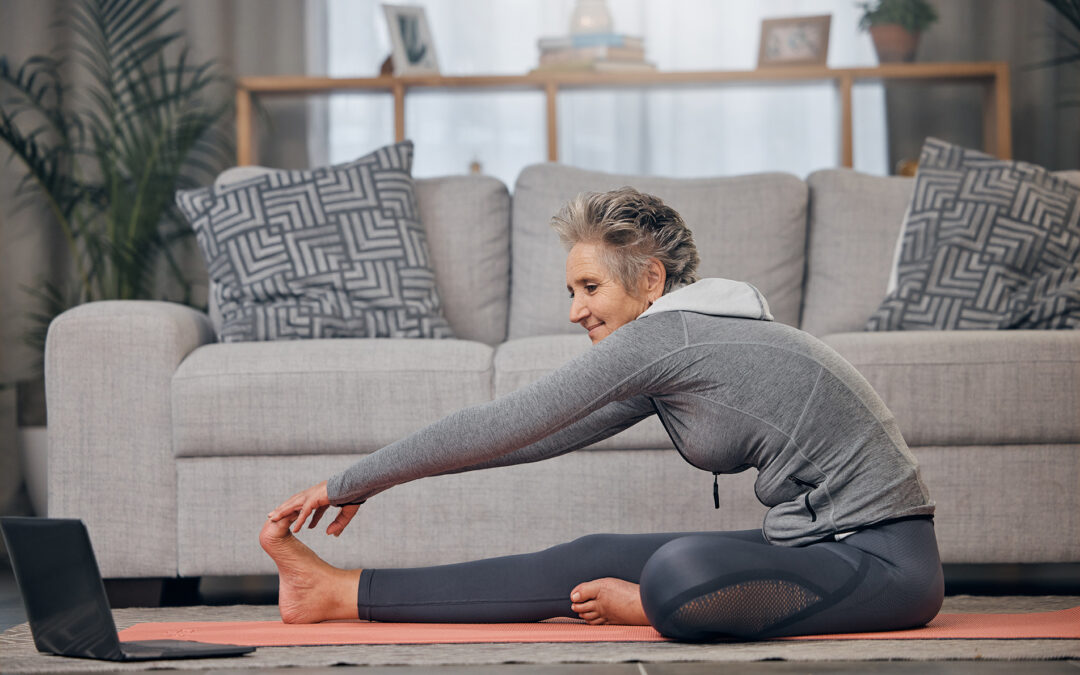
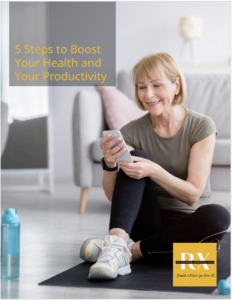 Yes, I want to read the Five Steps to Boost my Health and Productivity
Yes, I want to read the Five Steps to Boost my Health and Productivity